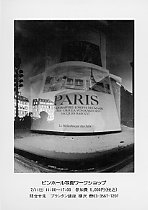三次元の現実を二次元に置き換える一点透視法はルネサンス時代に生まれた。フィレンツェの建築家兼技術者だったフィリッポ・ブルネレスキは、この一点透視法の理論を証明するために、「タヴォレッタ(小板)」と呼ばれる装置を考案した。
あらかじめ小板に一点透視法で建物を描き、絵を描いたときの画家の視点に小穴を開ける。絵が描かれたのと同じ位置に立ち、画家と同一の視点で絵の描かれていないほうの面から穴を覗き、その先に鏡を掲げる。すると、鏡に映った絵の建物が、現実の建物とぴったりと重なり合って見えるという仕掛けである
この仕掛けには、「小さな開口部」と「鏡」という非常に基本的な光学が使われている。近くのものと遠くのものとが虚実ないまぜになって見えるのは、描かれた絵が正確であるばかりでなく、われわれの視野が一つの小穴により狭められ、遠近の差が克服されるからである。
鏡のように光を反射する効果と、光を透過させる効果を併せ持つガラス板は、数百年を経た堅固な建物と、短いサイクルで入れ替わるはかない存在の陳列物を対峙させる。実際には触ることも互いに交わることも決してできない両者から「虚と実」、「外と内」、「前と後」、「遠と近」の境界線を取り払い、ガラス板そのものは光あるいは闇の中に永遠に消滅する。
パリの日曜は目覚めが遅い。狭い路地を隔てたアパートの住人を起こさぬよう、ショーウィンドーに貼り付くようにして手製のピンホールカメラを置き、光による「軌跡」と「奇跡」を待つこと数分。針穴とガラス板は、現代の虚実融合装置「タヴォレッタ」の二つの要素である。
田所美惠子
The perspective which transfers 3D reality
into 2D was born in Renaissance. Filippo Brunelleschi, Florentine architect
and engineer,thought up an apparatus named "tavoletta (small plate)"
in order to demonstrate the principle of the perspective.
First of all, he paints the buildings in
front of him on a small plate in conformity with the perspective and pierces
a small hole corresponding to his point of view. Then he stands at the
same place and at the same point of view as he painted, peeps through the
hole from the reverse side of the plate and puts up a mirror behind the
plate. It is at this moment and with this apparatus you can see overlap
the painted buildings reflected in the mirror with the real buildings.
In this apparatus the fundamental optics
such as "small aperture" and "mirror" are utilized.
We can see a fusion of far and near confusing real and virtual because
not only the painting itself is precise but also a tiny hole, by which
is narrowed our vision, helps us to overcome the gap of far and near.
A window glass having the mirror-like effect
of reflecting the light and the transparent effect of seeing through at
the same time confronts the solid and aged buildings with the ephemeral
displayed objects in the window but to be replaced in a short term. It
blurrs the border of "real and fake", "inside and outside",
"front and rear" and "far and near", which we never
touch and which never intermingles themselves in the reality, and the glass
itself disappears forever in the light,,, or in the darkness.
The Sunday morning in Paris is late. Not
to wake up the habitants of appartments facing a narrow path, I put my
handmade pinhole camera leaning upon a show-window and wait a while for
a "trace" and a "miracle" of the light. A pinhole and
a window glass are the two elements of a modern tavoletta fusionning real
and virtual.
Mieko TADOKORO
La perspective qui interprète une réalité de 3D en 2D est née à la Renaissance. Filippo Brunelleschi, architecte et ingénieur florentin, conçut un appareil nommé "tavoletta (petite plaque en bois)" afin de démontrer le principe de la perspective.
D'abord, il peint des bâtiments devant
lui sur une petite plaque en conformité avec la perspective et y
perce un petit trou qui correspond à son point de vue. Puis, il
se met au même endroit et au même point de vue auquel il a
peint, regarde au travers de ce trou mais de derrière de cette plaque
et ensuite hisse un miroir derrière la plaque. C'est à ce
moment et avec cet appareil que vous pouvez voir s'assimiler les bâtiments
peints reflétés dans le miroir aux bâtiments réels.
Dans cet appareil sont utilisées des
optiques fondamentales comme la "petite ouverture" et le "miroir".
On peut voir fusionner le loin et le près confondant le réel
et le virtuel, non seulement parce que la peinture elle-même est
précise mais également qu'un petit trou, par lequel se réduit
notre vision, nous permet de surmonter un décalage entre le loinet
le près.
Une vitre ayant l'effet de miroir qui reflète
la lumière et l'effet de transparence qui fait traverser la lumière
en même temps fait confronter des bâtiments solides et agés
avec des objets éphémères étalés dans
la vitrine mais à remplacer à court terme. Elle brouille
la frontière de "vrai et faux", "intérieur
et extérieur", "devant et derrière" et "loin
et près",qu'on peut jamais toucher et qui s'entremêlent
jamais dans la réalité, et la vitre elle-même disparaît
à jamais dans la clarté,,, ou dans l'obscurité.
A Paris le jour se réveille tard le
dimanche. Afin de ne pas réveiller des habitants des appartements
faces à une rue étroite je met ma chambre noire faite-main
en m'appuyant sur une vitrine et attend quelques moments une trace et un
miracle de la lumière. Un sténopé et une vitre sont
les deux éléments d'une tavoletta moderne fusionnant le réel
et le virtuel.
Mieko
TADOKORO
TAVOLETTA - apparatus fusionning real and virtual
タボレッタ ‐ 虚実融合装置 |
 |
田所美惠子 ピンホール写真 in パリ
Pinhole Photographs by Mieko Tadokoro in Paris |
| July 9 to 15, 1998 |
Galerie de Printemps Ginza
ギャルリィ・ドゥ・プランタン |
| |


